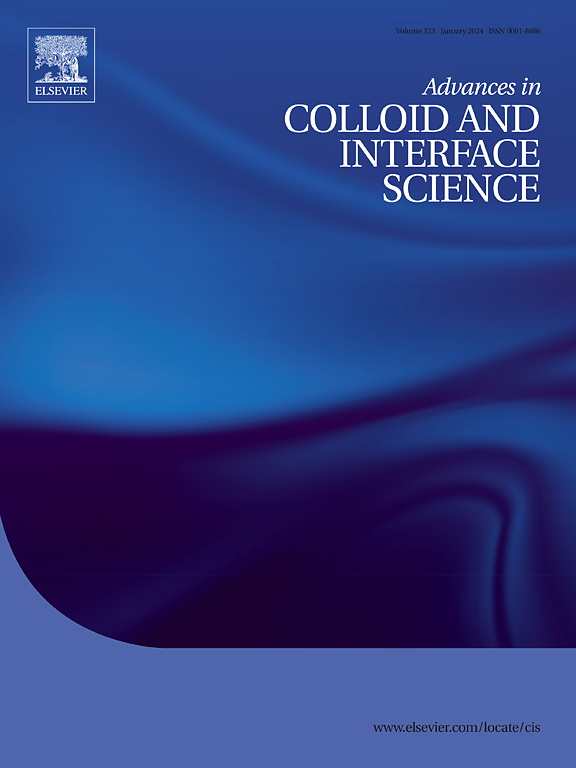Pickering emulsion gels stabilized by protein and polysaccharide-based particles: A review of stability, synthesis, applications and prospective
IF 19.3
1区 化学
Q1 CHEMISTRY, PHYSICAL
引用次数: 0
Abstract
With a far longer stability than traditional emulsions, Pickering emulsion gels (PKEGs)—stabilized by solid particles—have proven highly efficient in a range of applications during recent years. Particles based on proteins or polysaccharides with distinctive amphiphilic structure are particularly well-suited for the production of PKEGs because of their natural occurrence, low cost, high nutritional content, and potential health advantages. Thus far, it has been shown that plant and animal proteins, as well as their complexes with polysaccharides, effectively stabilize PKEGs. The three main mechanisms that protein-based particles (Pr-Particles) stabilize PKEGs are the formation of a densely packed interfacial layer due to the irreversible adsorption of Pr-Particles, the accumulation of non-adsorbed Pr-Particles at the plateau borders or the formation of a gel-like network in the continuous phase, which decreases drainage, and depletion stabilization. In some applications, each type of Pr-Particles may provide exceptional advantages. This paper summarizes the main functions of PKEGs stabilized by proteins or polysaccharides, looks at the key mechanisms governing gel stability to better understand the complex behavior of PKEGs, and highlights the important scientific, technological advancements being deployed in the food industry using PKEGs. Some important applications of PKEGs in the food and nutraceutical fields are delivery of bioactive compounds, modulation of lipid digestion, fat substitution and design/formulation of novel products including 3D printed foods, which have been covered in the current study.

蛋白质和多糖基颗粒稳定的酸洗乳凝胶:稳定性、合成、应用和展望
与传统乳液相比,皮克林乳液凝胶(PKEGs)的稳定性要长得多,近年来,固体颗粒稳定的皮克林乳液凝胶在一系列应用中被证明是高效的。以蛋白质或多糖为基础的颗粒具有独特的两亲性结构,由于其天然存在、低成本、高营养含量和潜在的健康优势,特别适合生产PKEGs。到目前为止,已经证明植物和动物蛋白及其与多糖的复合物可以有效地稳定PKEGs。蛋白质基颗粒(Pr-Particles)稳定PKEGs的三个主要机制是:由于pr -颗粒的不可逆吸附而形成致密堆积的界面层,未吸附的pr -颗粒在高原边界积聚或在连续相中形成凝胶状网络,从而减少排水,以及耗竭稳定。在某些应用中,每种类型的Pr-Particles都可以提供特殊的优势。本文综述了由蛋白质或多糖稳定的PKEGs的主要功能,着眼于控制PKEGs凝胶稳定性的关键机制,以更好地了解PKEGs的复杂行为,并重点介绍了PKEGs在食品工业中应用的重要科学技术进展。PKEGs在食品和营养保健领域的一些重要应用是生物活性化合物的输送、脂质消化的调节、脂肪替代和新产品的设计/配方,包括3D打印食品,这些已经在目前的研究中得到了覆盖。
本文章由计算机程序翻译,如有差异,请以英文原文为准。
求助全文
约1分钟内获得全文
求助全文
来源期刊
CiteScore
28.50
自引率
2.60%
发文量
175
审稿时长
31 days
期刊介绍:
"Advances in Colloid and Interface Science" is an international journal that focuses on experimental and theoretical developments in interfacial and colloidal phenomena. The journal covers a wide range of disciplines including biology, chemistry, physics, and technology.
The journal accepts review articles on any topic within the scope of colloid and interface science. These articles should provide an in-depth analysis of the subject matter, offering a critical review of the current state of the field. The author's informed opinion on the topic should also be included. The manuscript should compare and contrast ideas found in the reviewed literature and address the limitations of these ideas.
Typically, the articles published in this journal are written by recognized experts in the field.

 求助内容:
求助内容: 应助结果提醒方式:
应助结果提醒方式:


